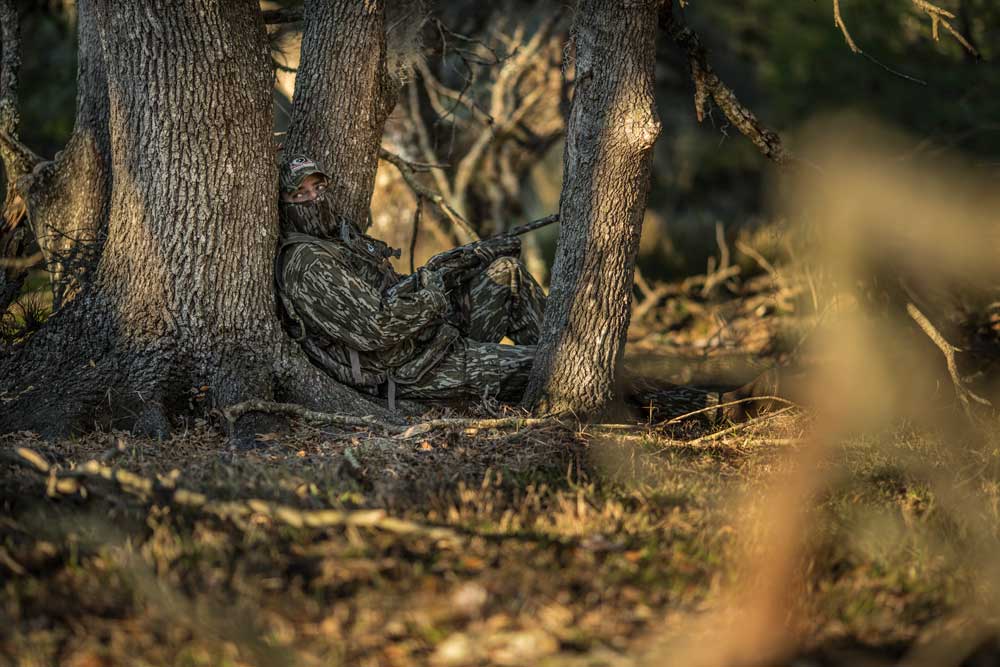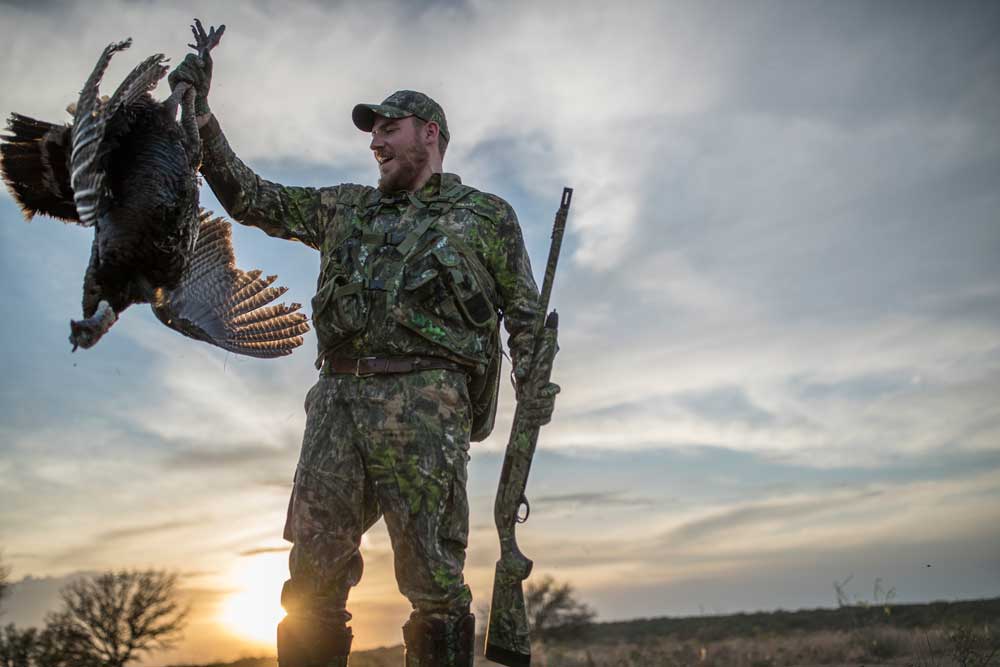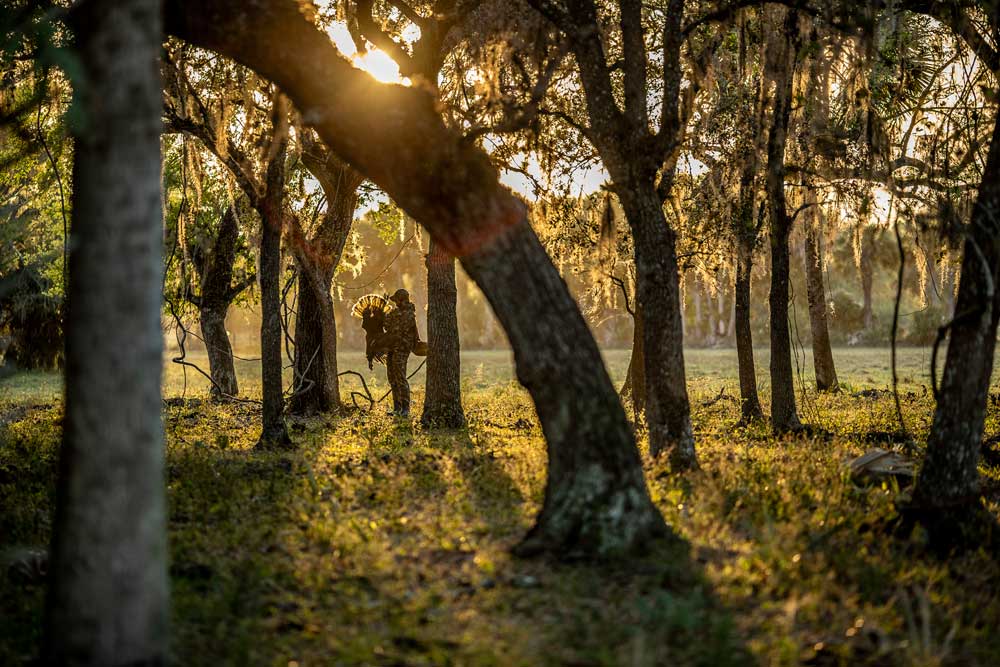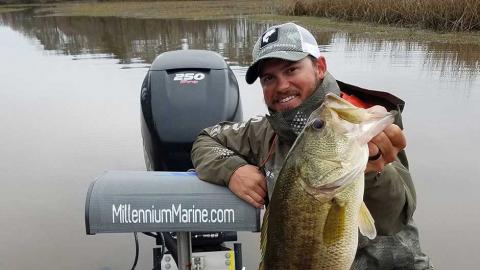Donald Devereaux Jarrett | Mossy Oak ProStaff

I was tired, completely worn out. The season was winding down for me, and I was a thousand miles from nowhere sitting in a mesquite flat in south Texas. I had hunted nearly every day of the season to this point and was now looking for ways to hang on to a season I knew was almost over. So, here I was trying to pick just a little more fruit. We’ve all been there at some point. I limited out back in Georgia inside the first week of April. I spent that time, from then ‘till Texas, hunting with others. Not carrying a gun, after all, didn’t end the season and it certainly didn’t stop the fun.
But now, chasing the end of the season in Texas, I knew this was the beginning of the end. I struggle each year to let go of the season and when the grip of it is pried from me, I immediately begin counting the days down until the next spring, in all its glory, arrives.
So how do we manage to end on a good note when we are down to the final curtain of our season? We have to learn to hunt turkeys in a transition period where gobblers have to make up their minds about which direction they want to go once their feet leave the limb. Will they spend another day trying to wrangle up one more receptive hen, or would they rather call it a season themselves and just go back to hanging out with the guys?
Then there’s the hen issue. It is alive and well in a lot of places; even late in the season. They still present a challenge, too.
And of course, at least in places like Texas, we must contend with the heat. Sometimes it is brutal, particularly late in the season.
We don’t have the luxury of picking the perfect scene for the days we hunt so, we have to go with the hand we are dealt and make the most of it. When you do, it is a reward worth working for.
Gobblers in a state of confusion
OK, maybe they aren’t really confused, but gobblers can appear clueless when the season is winding down. They have days where nothing seems amiss until you catch one by himself that won’t so much as look in the direction of the call you just sent. “What is he doing?” we wonder.
Gobblers begin a change of attitude that will drive you crazy when the season gets late. The same bird that you watched gobble himself into hysteria the morning before, might be completely oblivious to a willing hen the next day. Don’t take it personally, they are just doing what turkeys do. We have our own vision of what turkeys do when they are acting like turkeys, but to increase our chance of throwing a late season bird over our shoulder, we can’t forget about the ones that step outside our ”vision.” We can’t force it to happen.
While guiding in South Dakota, good friend and outfitter Mike Moody and I used to have a saying: “It happens when it happens.” That statement has not changed in all my years of chasing turkeys and it never will. We simply cannot make a turkey do anything he doesn’t want to do. The key is finding out what he wants to do and then cashing in on it. We have to be ready for anything and we have to have an answer for it. That is something that I wish I could do more often. Many times though, we are left scratching our heads and thinking evil thoughts about the turkeys we love so much.
I had no idea what I was getting into when I ventured to Texas to hunt with my friend Nathan Mason, but our outfitter Chuck Ward explained the possibilities before we ever decided to go that late in the season. He told us to expect a tough hunt but added that the possibility of taking an exceptional bird was strong. He was correct on both accounts.
So, back to the confused gobblers and the challenge they present. We saw gobblers that seemed to have no inclination about breeding in one area and then, just up the road, we would see gobblers trying their best to impress the hens. We saw gobblers that never slowed down to investigate the calls we made, and a few that had no problem covering a lot of ground to see what we had to offer.
When gobblers become wishy-washy about their daily intent, it falls upon us to figure it out. You can either sit in a well-used area and let them know you are there, or you can cover some ground. If you choose the first option, be prepared to exercise a lot of patience. This method isn’t for everybody, but it can page huge dividends for those willing to stay put. The thought here is that your calling will eventually be heard by a bird that might just come investigate. It’s always nice to have one let us know he’s in the area before he shows up but don’t expect that to happen every time you decide to set up in an area for as long as it takes. You absolutely have to stay focused and ready. If the bird does happen to give you a courtesy gobble, expect him to come. He won’t every time, but you have to assume that he will.
Covering ground still ranks as my favorite method of killing a bird, at any point of the season, but only if they are talking. I just don’t have as many happy endings walking and calling when the birds aren’t saying much. Too many times I have run headlong to an approaching bird that never opened his mouth. It is possible to move from one location to another and spend a while in one area before moving to another. It’s a happy medium between the two options and can be productive as well. Let the bird dictate your method instead of trying to dictate to him how you want to hunt him. There’s nothing wrong with trying to set the tone, but base your approach on how to hunt him according to his reaction to what you do. It’s still all about reading the bird.
Those Dreaded Hens

While hens abound in the early weeks of a season, I’m convinced that, at least in many areas, the gobblers don’t ever seem to run out of them. This season, for example, the hens were interfering all the way to the last sunset. When I first began turkey hunting I was under the impression that some great hunting could be had late in the season when the hens were far and few between. I still believe that is the truth, but I have also learned that there are often hens in abundance in some areas that can cause some serious headaches even as the season winds down. So, I think we must treat them as we would at any other point of the season. And we need to understand that they, too, are transitioning to another stage of the year. Some have been bred and are setting on a nest, some are still laying and others may be raising a brood. But there are still others that might not have been bred and some that may feel the need to be bred again for other reasons. It is a fact that some hens will breed multiple gobblers and that nature will determine which gobbler gets to be the daddy. So those things, along with the hens that have had their nests destroyed, can add up to a lot of hens still distracting gobblers from your calling late in the season.
We tend to blame hens less often late in the season when a gobbler flies down and leaves you high and dry as his gobbles fade into the distance, but it does happen, even if a hen has no intention of spending any time with the tagalong tom. When a gobbler is in a breeding state of mind, all he needs to do is hear one or see one, regardless of her intent.
Remember early in the season when a lot of hens aren’t ready to be bred but he won’t leave them? It can be exactly like that late in the season as well. In the case of late-season hens, it’s good if we can determine what stage the hen is in. If we can figure it out, we have a better chance at getting the gobbler. Setups between hens and gobblers are great places to start the day and when gobblers are hammering and hens are slipping away, we need to capitalize on that scenario ASAP.
Regardless of the hens, there are still gobblers to be had and persistence is always key.
Renegade Jakes
These guys can ruin a hunt at the drop of a hat. Jakes have spent a large portion of the season running around in bachelor groups. They likely have been taught a lesson or two along the way and one lesson is that there are strength in numbers. I have watched groups of jakes run off mature gobblers that were just steps away from reaching gun range. I have hunted in various states across the country in what could easily be called, “The Year of the Jake.” It can be frustrating to say the least. Such was the case in Texas. I called in a bunch of them while we were there but very few solo jakes. Most came to the call in bunches, five to even ten at the time.
Generally, when the longbeards are greatly outnumbered, the jakes rule the roost. They know it and the jakes know it. If you hunt these areas when they are infested with jakes, you will soon know it too. Mature gobblers are sometimes reluctant to gobble in areas with higher than average numbers of jakes and they are even more hesitant to show up to your setup. Again, stay at the ready for the sneaky gobbler to slip in here. He might not open his mouth for fear of being beat up by a gang of renegade jakes, but given enough time, he may decide to see if he can slip in quietly to your calling. There is really no surefire way to beat the jakes so patience is key here.
Remember, just because jakes are running the show in an area doesn’t mean that the big boys don’t still want to breed, and it doesn’t mean that they don’t get it done. Oftentimes mature gobblers may roost in an entirely different area than where the jakes and hens might roost. These birds will wait for the jakes to clear out and might get fairly vocal if they believe it is safe to do so.
One of the birds I killed in Texas was one that had roosted several hundred yards from the group of birds I had set up on at daylight. There were a handful of jakes and several hens that flew down and paraded off in a different direction. The bird I ended up killing began answering my call well over an hour after these birds drifted away. When he no longer felt threatened, he began to work to me and I shot the solid, mature bird at 17 yards. He had come a long way. I was set up less than 30 yards from where I had started my hunt at daylight.
Don’t let jakes make you think that you can’t kill a long beard in an area they dominate. The important thing is to hang tough and at least look for the silver lining. While they can drive you crazy, enjoy the fact that all those jakes sure make next spring look promising.
Hot Gobblers

One of the worst weather conditions for hunting turkeys is of the hot variety. I rate hot weather as the number one toughest condition to hunt turkeys in. High temperatures are not only rough on the hunter but they are rough on the turkeys as well. When the temperature rises, turkeys generally slow down - way down. Obviously, when the weather turns hot, the best action you’re likely to get in on will be early in the morning. Everything will be hotter than the morning until after sundown.
The first one I killed in Texas was on the first morning we hunted, and he had lots of hens and jakes around him before he broke and came strutting in. It happened well before the temperatures began to climb, and he treated the morning just like a young subordinate bird would. The jakes, thick in the area, flew down and marched off with the hens in the opposite direction of our setup. Realizing that a hen was all by herself, away from the departing group of jakes, the big boy began to fire up. He didn’t ever get going well until the jakes and hens got far enough away for him to feel comfortable. Then he covered the remaining 200 yards in full strut, gobbling plenty. He didn’t stop gobbling until I squeezed the trigger. As Nathan and I walked over to the bird, I was thinking he was a subordinate, younger bird. When I wrapped my hands around his scaly legs, I realized that he was likely a bird that simply had been pushed to the side by a large number of jakes. Spurs of 1 5/8” don’t lie.
If you haven’t gotten a bird flopping by mid to late morning, things can get really tough. Turkeys feel it just like we do and when they get hot, they are heading to the shade. Usually, when they find their shady loafing area, they lock it down there, many times all day long, and never let loose of another gobble for the rest of the day.
This is when you will have to decide whether to tough it out or take a break until some sense of coolness returns later in the evening. If you can stand it, finding your own shady spot to loaf can produce, as some gobblers prefer to loaf in the heat of the day from one shady spot to another. They might not cover as much ground as they will on a cooler day, but some of them prefer to move about in search of a willing participant. If you decide to stay in the woods, occasional calling is generally your best bet. And don’t expect a screaming, suicidal gobbler to come running in either. Most hot weather birds tend to slip in quietly, exerting little of the energy they have left after the heat of the day has drained a large portion of it already.
If you plan to take a break, I’d still plan to head back out in the early evening in order to get where you plan to be before it cools down too much. It’s better to be there when it happens than afterwards. Turkeys that have loafed around in the shade most of the day will oftentimes begin to stir about when it begins to cool off some. Getting in close proximity of known roosting areas can pay huge dividends. Be in the area you expect birds to congregate later in the evenings before they head to roost.
The season is a continuous transition, day by day, until one morning we will wake up and it will all be over until the next one. Hang on to it as long as you can and change with the birds. Remember, a lot of birds would still be alive if the season had ended a day earlier.



























